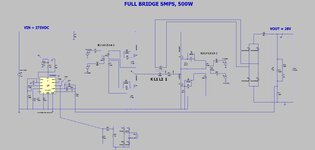cupoftea
Advanced Member level 5
Hi,
Just seen a Full Bridge with Vin = 200Vdc. (output of 115VAC PFC)
Fsw = 47kHz.
Its gate drive is two pulse transformers each with 2 secs........for each leg......bipolar drive....in each secondary is only a 12R series resistor and 12k gate_source res.
No gate zener (back to back)
Would you think this was unadviseable?
Just seen a Full Bridge with Vin = 200Vdc. (output of 115VAC PFC)
Fsw = 47kHz.
Its gate drive is two pulse transformers each with 2 secs........for each leg......bipolar drive....in each secondary is only a 12R series resistor and 12k gate_source res.
No gate zener (back to back)
Would you think this was unadviseable?
